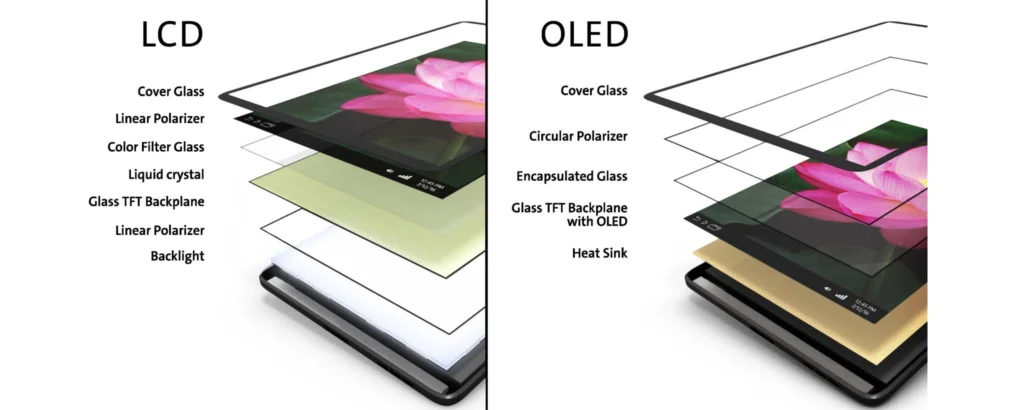OLED vs LCD: Unpacking the Revolutionary Display Tech Showdown 0:
In the dynamic world of display technology, two titans stand prominent: Liquid Crystal Displays (LCDs) and Organic Light-Emitting Diodes (OLEDs). While both aim to deliver captivating visuals, their underlying principles and resultant performance characteristics vary significantly, impacting everything from picture quality and energy efficiency to cost and longevity.1 Understanding these differences is crucial for consumers and professionals alike when selecting the ideal display for their needs, whether it’s for a smartphone, TV, monitor, or specialized industrial application.
The Fundamental Difference: How They Light Up
The core distinction between LCD and OLED lies in how they produce light. LCDs are emissive displays, meaning they rely on a separate backlight to illuminate their pixels. This backlight, typically composed of Light Emitting Diodes (LEDs), shines through a layer of liquid crystals that act as shutters, controlling the amount and color of light that passes through to create the image.2 This architecture, while robust and cost-effective, inherently limits the display’s ability to achieve true black, as some light from the backlight will always bleed through, even in areas intended to be dark.3
OLEDs, on the other hand, are self-emissive.4 Each individual pixel in an OLED display is an organic light-emitting diode that generates its own light when an electric current is applied.5 This revolutionary approach allows for pixel-level control over brightness and color.6 When a pixel needs to display black, it simply turns off completely, resulting in absolute black levels and an infinite contrast ratio.7 This fundamental difference underpins many of the performance advantages OLEDs offer.
Picture Quality: A Feast for the Eyes
When it comes to picture quality, OLED displays often hold the upper hand, particularly in terms of contrast, black levels, and color accuracy.8
Contrast and Black Levels: This is where OLED truly shines. Because each pixel can turn off independently, OLEDs can achieve perfect blacks, leading to an unparalleled contrast ratio.9 Dark scenes in movies and games appear incredibly deep and rich, with bright elements standing out vibrantly.10 LCDs, even those with advanced local dimming technologies (which attempt to dim specific backlight zones), struggle to match this due to the inherent backlight bleed.11 This means that blacks on an LCD will often appear as a dark gray.
Color Accuracy and Saturation: OLED displays generally offer a wider color gamut and more accurate color reproduction.12 The self-emissive nature of OLED pixels allows for greater precision in rendering colors, leading to more vibrant and lifelike images.13 While modern LCDs, especially those incorporating Quantum Dot technology, have made significant strides in color performance, OLED still tends to provide a more natural and accurate color experience, particularly crucial for professional photo and video editing.
Viewing Angles: OLED displays boast nearly perfect viewing angles.14 Colors and contrast remain consistent even when viewed from extreme off-center positions. This is a significant advantage over many LCD panels, which can experience color shifting, reduced contrast, and a noticeable “wash-out” effect when viewed from an angle.15 This makes OLED ideal for shared viewing experiences, such as watching a movie with family and friends. For more information on display technology and its evolution, consider exploring resources like the Society for Information Display.
Response Time: OLED panels typically have much faster response times than LCDs, often measured in microseconds compared to milliseconds for LCDs.16 This translates to smoother motion handling, with less motion blur and ghosting, making OLED a preferred choice for fast-paced gaming and action-packed content.17
Energy Efficiency: A Complex Equation
The energy consumption of LCD and OLED displays is not a straightforward comparison and heavily depends on the content being displayed.
Dark Content: When displaying dark images or using dark modes (like a dark theme on a smartphone or computer), OLED displays are significantly more energy-efficient.18 Since individual pixels can be turned off, they consume no power in black areas. This is a considerable advantage for devices with dark user interfaces or for watching content with a lot of dark scenes.
Bright Content: Conversely, when displaying bright or predominantly white content, LCDs often become more energy-efficient.19 Because an LCD’s backlight is always on, its power consumption remains relatively constant regardless of the image.20 For OLEDs, lighting up all pixels at high brightness requires more energy, potentially leading to higher power consumption than an LCD in such scenarios.21 For a deeper dive into the specifics of display power consumption, a technical resource like Reshine Display’s blog offers valuable insights.
Longevity and Durability: The Trade-Offs
Both technologies have their strengths and weaknesses concerning lifespan and durability.
LCD Longevity: LCDs generally have a longer theoretical lifespan and are less susceptible to “burn-in.” As they don’t rely on organic materials, they are more resistant to degradation over time and are less prone to permanent image retention, which can occur if static images are displayed for extended periods on an OLED screen.22 LCDs are also typically more robust and resistant to physical impact.23
OLED Burn-in: The primary concern with OLED displays is the potential for “burn-in,” also known as permanent image retention.24 This happens when static images (like channel logos, status bars, or game HUDs) are displayed for prolonged periods, causing the organic materials in those pixels to degrade unevenly, leaving a faint ghost image.25 While manufacturers have implemented various technologies to mitigate burn-in, it remains a consideration, especially for devices that display static content frequently. However, for typical consumer use with varied content, burn-in is less of a concern than it once was.
Cost: A Question of Technology and Scale
Historically, OLED displays have been significantly more expensive to manufacture than LCDs due to their complex production processes and the use of specialized organic materials.26 This cost difference has meant that OLED technology has primarily been adopted in premium devices and high-end televisions.27
However, as OLED production matures and economies of scale are achieved, the price gap is gradually narrowing. While LCDs generally remain the more affordable option across various device categories, the cost-effectiveness of OLED is improving, making it more accessible to a broader market.
Applications: Choosing the Right Display for the Job
The choice between LCD and OLED often comes down to the specific application and user priorities.
LCD Strengths:
- Affordability: Ideal for budget-conscious consumers and mass-market devices.
- Brightness: Excellent for use in brightly lit environments or outdoors due to their powerful backlights.
- Longevity and Durability: Preferred for applications where displays are subjected to long hours of use with static content or require high resistance to impact.
- Large-Format Displays: Cost-effective for very large screens, such as public signage or large-format TVs.
OLED Strengths:
- Premium Picture Quality: Best for critical viewing experiences like cinematic content, high-end gaming, and professional color grading.28
- Deep Blacks and Infinite Contrast: Creates a truly immersive visual experience.29
- Wide Viewing Angles: Ideal for shared viewing and applications where consistent image quality from various positions is crucial.30
- Thin and Flexible Designs: The absence of a backlight allows for incredibly thin and even flexible display designs, paving the way for innovative form factors in smartphones and wearables.31 For further exploration of display advancements and their applications, delve into resources like Corning’s insights on display glass.
The Evolving Landscape
Both LCD and OLED technologies are continually evolving. LCDs are seeing advancements like Mini-LED backlighting, which uses thousands of tiny LEDs to offer more precise local dimming and higher contrast, blurring some of the lines with OLED performance. Similarly, OLED technology is improving in terms of brightness, lifespan, and burn-in resistance.32 Innovations like Tandem OLED, which layers multiple OLED emission layers, are pushing brightness levels higher and extending lifespan even further.33
The “better” display technology isn’t absolute; it’s contextual. For those prioritizing absolute picture quality, especially deep blacks and vibrant colors, OLED often reigns supreme.34 However, for users seeking maximum brightness, long-term durability with static content, and a more budget-friendly option, advanced LCDs remain a highly compelling choice. The future promises continued innovation in both realms, offering consumers an even wider array of high-quality display options to suit every need and preference.

Check out our latest posts !


